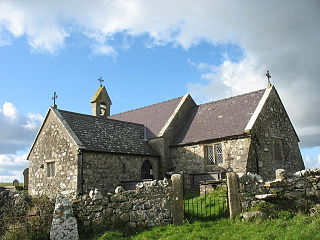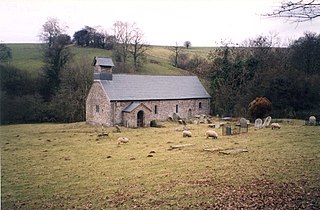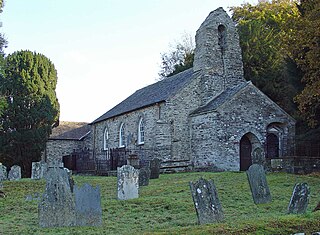| St Decuman's Church | |
|---|---|
 | |
| 51°41′N5°02′W / 51.68°N 5.03°W | |
| Country | Wales |
| History | |
| Dedication | St Decuman |
| Architecture | |
| Heritage designation | Grade I |
| Architectural type | Church |
St Decuman's is a Grade I listed building in Rhoscrowther, Pembrokeshire, Wales.
| St Decuman's Church | |
|---|---|
 | |
| 51°41′N5°02′W / 51.68°N 5.03°W | |
| Country | Wales |
| History | |
| Dedication | St Decuman |
| Architecture | |
| Heritage designation | Grade I |
| Architectural type | Church |
St Decuman's is a Grade I listed building in Rhoscrowther, Pembrokeshire, Wales.
The parish church is on a very early Christian site and is dedicated to Saint Decuman. It was the "bishop-house" of the cantref of Penfro and one of the seven principal churches in Dyfed under medieval Welsh law. [1] The church is in the care of Friends of Friendless Churches. [2]
Samuel Lewis in 1833 considered the church "not distinguished by any remarkable architectural details". [3] It was restored from 1852 and the roof was renewed in 1870. There was further restoration in 1910. It was Grade I listed in 1970. [4] [5]
It is constructed of rubble stone under a slate roof which carries a bellcote. The nave and chancel are possibly 13th century and the transept, chapel and tower 14th century. [4]
The font, in the north porch, is 12th or 13th century; the nave has a small Norman font. The church contains a number of tombs and memorials, including two recesses and wall-mounted coffin lids. The oldest dated memorial is a 1716 baroque monument to F Powell of Greenhill. The pulpit and lectern are 19th century, and windows range from the 19th and 20th centuries, as recently as 1960. [4]

Decuman was one of the Celtic saints who came to Somerset from South Wales, Pembrokeshire, in the seventh century, arriving on a raft with a cow for a companion. There he was a pastor and physician to the local inhabitants.

Rhoscrowther was a village, ecclesiastical parish and civil parish in Pembrokeshire, Wales on the south shore of the Milford Haven Waterway. The placename is Welsh and perhaps means "crwth-player's moor". It is part of the community of Angle.

St Peulan's Church, Llanbeulan is a redundant Anglican church in Llanbeulan, in Anglesey, north Wales. The nave, which is the oldest part of the building, dates from the 12th century, with a chancel and side chapel added in the 14th century. The church has a font of early date, possibly from the first half of the 11th century: one historian has said that it would initially have been used as an altar and that "as an altar of the pre-Norman period it is a unique survivor in Wales and, indeed, in Britain".

St Cristiolus's Church, Llangristiolus is a medieval church near the village of Llangristiolus, in Anglesey, north Wales. The village, about 1 mile (1.6 km) from the building, takes its name from the church. Reputedly founded by St Cristiolus in 610, the present building dates from the 12th and 13th centuries. Alterations were made in the 16th century, when the large east window in Perpendicular style was added to the chancel – a window which has been described by one guide to the buildings of north Wales as "almost too big to fit" in the wall. Some restoration work took place in the mid-19th century, when further windows were added and the chancel largely rebuilt.

St Mary's Church, Tal-y-llyn is a medieval church near Aberffraw in Anglesey, north Wales. It was originally a chapel of ease for the parish church of St Peulan's, Llanbeulan, but the township that it once served, Tal-y-llyn, no longer exists. It was declared a redundant church in the early 1990s, and has been in the care of the Friends of Friendless Churches since 1999. Services are held once per month during part of the year.

St Mary's Church is a redundant Anglican church in the village of Hardmead, Buckinghamshire, England. It is recorded in the National Heritage List for England as a designated Grade I listed building, and is under the care of the Friends of Friendless Churches.

St Mary's Church, Derwen, is a redundant church in the centre of the village of Derwen, Denbighshire, Wales. It is designated by Cadw as a Grade I listed building, and is under the care of the Friends of Friendless Churches.

St Ellyw's Church, is a redundant church in the village of Llanelieu, Powys, Wales. It is designated by Cadw as a Grade I listed building, and is under the care of the Friends of Friendless Churches. It is sited at the edge of the Black Mountains within the Brecon Beacons National Park.

St Michael and All Angels Church, Llanfihangel Rogiet, is a redundant church in the hamlet of Llanfihangel Rogiet near the village of Rogiet, Monmouthshire, Wales. It has been designated by Cadw as a Grade II* listed building and is under the care of the Friends of Friendless Churches. The church stands in a rural site between two farms, is near the Paddington-Swansea railway line, and close to the intersection of the M4 and M48 motorways. It can be approached only through a private farmyard.

St Brothen's Church, Llanfrothen, is a redundant church at the edge of the village of Llanfrothen, Gwynedd, Wales. It is designated by Cadw as a Grade I listed building because it is "a fine Medieval church retaining much of exterior and interior interest". It is under the care of the Friends of Friendless Churches.

Hodgeston Parish Church is a redundant church in the village of Hodgeston, some 1 mile (1.6 km) southeast of Lamphey, Pembrokeshire, Wales. It is designated by Cadw as a Grade II* listed building, and is under the care of the Friends of Friendless Churches.

Manordeifi Old Church is a redundant church in Manordeifi, Pembrokeshire, Wales. It is designated by Cadw as a Grade II* listed building, and is under the care of the Friends of Friendless Churches. The church stands near the River Teifi and worshippers were sometimes trapped when the river flooded. They were then ferried home in a coracle that was kept in the church porch for this purpose. The church is no longer used for regular worship, but the tradition of keeping a coracle in the porch continues. When it was stolen, local people raised money for it to be replaced.

St Baglan's Church, Llanfaglan, is a redundant church in the parish of Llanfaglan, Gwynedd, Wales. It is designated by Cadw as a Grade I listed building, and is under the care of the Friends of Friendless Churches. It stands in an isolated position in a field some 150 metres (164 yd) from a minor road.

The Old Church of St Afran, St Ieuan and St Sannan, Llantrisant, is a redundant church in the settlement of Llantrisant, Anglesey, Wales. It is designated by Cadw as a Grade II* listed building, and is under the care of the Friends of Friendless Churches. It is set in an isolated location off a country road and is adjacent to a farmstead.

St David's Church, Llangeview, is a redundant church sited in a round churchyard adjacent to the junction of the A449 and A472 roads 1 mile (1.6 km) to the east of the town of Usk in Monmouthshire, Wales. It has been designated by Cadw as a Grade I listed building, and is under the care of the Friends of Friendless Churches. It is Grade I listed because of its "exceptional interior" including a 15th-century rood-loft and "rare pre-Victorian box pews and fittings". The church stands in a churchyard that is almost circular, and is surrounded by a bank and the traces of a ditch.

St Andrew's Church, Bayvil, is a redundant church standing in an isolated position in the hamlet of Bayvil, some 2 kilometres (1.2 mi) to the northeast of Nevern, Pembrokeshire, Wales. It has been designated by Cadw as a Grade II* listed building, and is under the care of the Friends of Friendless Churches. It is listed Grade II* because it is "a scarce rural example of an unaltered Anglican church of its date".

St Beuno's Church, Trefdraeth is the medieval parish church of Trefdraeth, a hamlet in Anglesey, north Wales. Although one 19th-century historian recorded that the first church on this location was reportedly established in about 616, no part of any 7th-century structure survives; the oldest parts of the present building date are from the 13th century. Alterations were made in subsequent centuries, but few of them during the 19th century, a time when many other churches in Anglesey were rebuilt or were restored.

St Eugrad's Church, Llaneugrad is an isolated church near the village of Marian-glas, in Anglesey, north Wales. A church was supposedly founded here by St Eugrad in about 605, although the earliest parts of the present structure are the nave, chancel and chancel arch, which date from the 12th century. A side chapel was added to the north in the 16th century, and some moderate restoration work was carried out in the 19th century. It contains a 12th-century font, a 13th-century carved stone depicting the crucifixion, and a memorial to one of the officers killed when the Royal Charter sank off Anglesey in 1859.

St Mary's Church, Llanfair-yn-y-Cwmwd is a small medieval parish church near the village of Dwyran, in Anglesey, north Wales. The building probably dates from the 15th century, with some alterations. It contains a 12th-century carved stone font and a 13th-century decorated coffin lid. The bell is inscribed with the year of its casting, 1582. The historian Henry Rowlands was vicar of St Mary's in the late 17th and early 18th centuries. Maurice Wilks, who invented the Land Rover, is buried in the churchyard.

The Church of St Jerome stands in the settlement of Llangwm Uchaf, (upper) Llangwm, in a remote part of Monmouthshire, Wales. Originally constructed in the twelfth century, in an Early English style, it was heavily restored in the nineteenth century. The church has a "large and unusual" tower, an "outstanding" late medieval rood screen and Victorian interior fittings of "exceptional quality". After being declared redundant by the Church in Wales, the church is now administered by the Friends of Friendless Churches. It was designated a Grade I listed building on 19 August 1955.